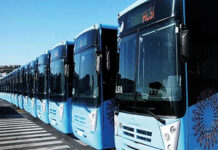Morocco experienced a dramatic decrease in forest fires and burned areas in 2024, with a total of 780 hectares affected compared to 6,100 hectares in 2023, representing a reduction by a factor of seven, according to the National Agency for Water and Forests (ANEF).
Throughout the country, 270 fires were recorded, burning a total of 780 hectares, with an average of 2.9 hectares burned per fire, ANEF stated in a report on forest fires between January 1 and August 31, 2024. Of the burned area, 430 hectares consisted of forested areas (55%), while 350 hectares were secondary species and herbaceous formations (45%).
Compared to 2022, the data for 2024 show a 40% reduction in fire outbreaks, from 375 fires, followed by a 30% decrease in 2023 (350 fires), and a 15% drop compared to the decade average (2014-2023) of 310 fires. The total burned area in 2024 remains significantly below the decade average of 4,800 hectares, marking a reduction by a factor of 5.5. The area burned per fire in 2024 was 15 times smaller than in 2022 (45.6 ha/fire) and four times less than in 2023. When compared to the decade average, the area burned per fire is three times smaller (11 ha/fire).
In terms of burned area, 2024 saw a reduction of 29 times compared to 2022, when the record high of 22,490 hectares was burned.
Geographically, the Fès-Meknès region was the most affected this year, with 40 fires burning 350 hectares, followed by Tanger-Tétouan-Al Hoceima (87 fires, 271 hectares) and the Oriental region (112 hectares). This marked improvement is attributed to several factors, including favorable weather conditions, with forest areas at risk benefiting from conditions less conducive to the outbreak and spread of fires over the past three months.
The success is also due to a strategy of early fire response, as the prevention policy adopted by partners including the Ministry of the Interior, ANEF, Civil Protection, and the Royal Armed Forces, among others, allowed 80% of fire outbreaks to be contained before reaching one hectare. In total, 94% of fires were contained before they spread to five hectares, and only two fires exceeded 100 hectares, in Taza (162 ha) and Tétouan (156 ha).
Additionally, aerial firefighting capabilities were strengthened with the acquisition of a seventh Canadair aircraft and the strategic deployment of the aerial fleet in high-risk areas, enabling rapid intervention and limiting the impact of large fires. These aircraft were mobilized in seven major fires, conducting around 250 water drops and protecting 19,000 hectares of forest.
Awareness campaigns held on the National Forest Fire Awareness Day (May 21) and the dissemination of Forest Fire Risk Bulletins (BRIF) during critical periods helped raise public awareness and reinforce collective vigilance.
Morocco stands out in the Mediterranean region with the lowest rate of burned area relative to its total forested area. According to the European Forest Fire Information System (EFFIS), the areas burned in other Mediterranean countries this year are significantly higher: Spain (38,058 ha), Italy (36,449 ha), Greece (31,758 ha), Portugal (12,407 ha), and France (11,857 ha).
ANEF also emphasized that the monitoring and intervention system remains at its optimal level, as September is still considered a high-risk period. The agency urged forest users, such as campers, beekeepers, and herders, to remain vigilant, stressing the importance of limiting the use of fire and immediately reporting any fire outbreaks or suspicious behavior to the authorities.
“Protecting our forest heritage is essential to preserving its vital socio-economic and environmental role,” the statement concluded.





